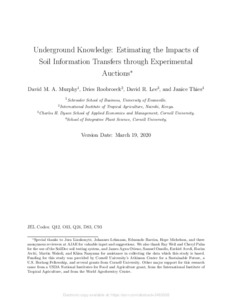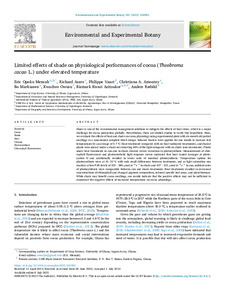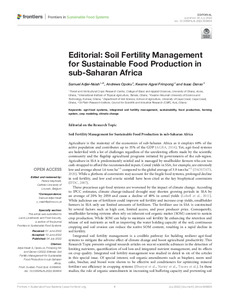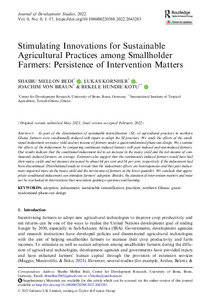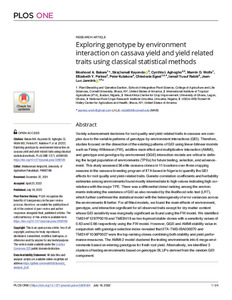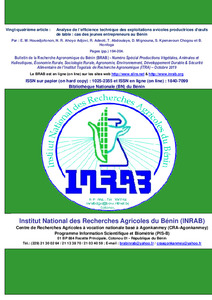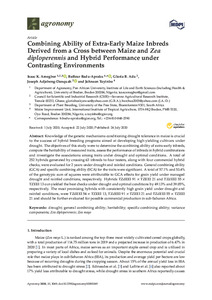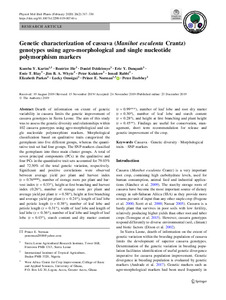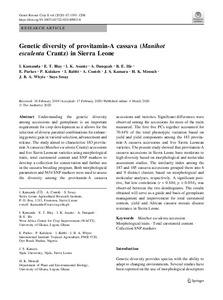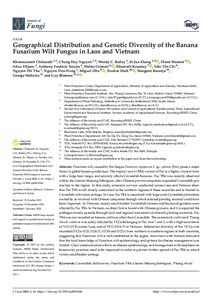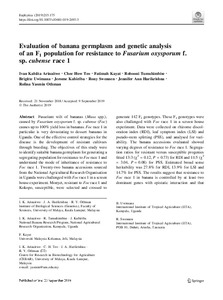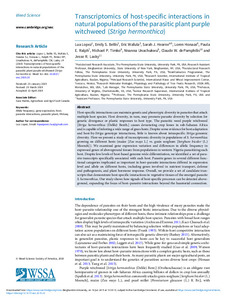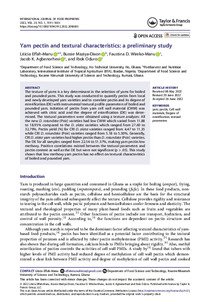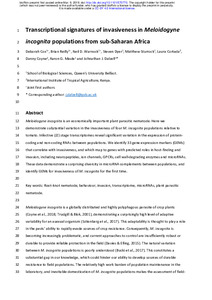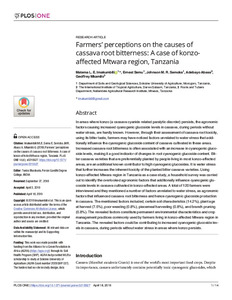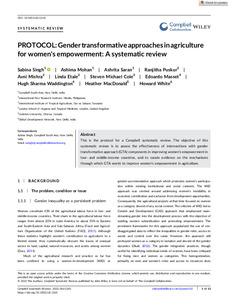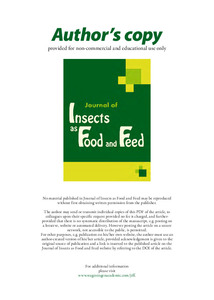Welcome to the International Institute of Tropical Agriculture Research Repository
Journal and Journal Articles: Recent submissions
Now showing items 581-600 of 5157
-
Underground knowledge: estimating the impacts of soil information transfers through experimental auctions
(2020-10-06)Soil degradation, a serious environmental problem in many developing countries, often necessitates the use of fertilizers to improve crop yields. However, smallholders usually do not have sufficient information about their soil nutrient levels to make profit‐maximizing decisions about fertilizer usage. We conducted two‐round experimental auctions to determine whether providing information and fertilizer recommendations from inexpensive soil testing kits to farmers in western Kenya affected their ... -
Women eat more rice and banana: the influence of gender and migration on staple food choice in East Africa
(2020-04-28)An original approach was used to examine how staple food choice differs by gender and migration: this consisted of a quantitative survey (six locations with urban consumers from various economic classes (n = 123)), a qualitative in-depth interview with a subset of those consumers (n = 18), and focus group discussions (n = 13). Men and women had similar results in terms of their preferred staple food choice attributes; yet women indicated consuming more rice and banana, and men, more maize and ... -
Limited effects of shade on physiological performances of cocoa (Theobroma cacao L.) under elevated temperature
(2022)Shade is one of the recommended management solutions to mitigate the effects of heat stress, which is a major challenge for cocoa production globally. Nevertheless, there are limited studies to verify this hypothesis. Here, we evaluate the effects of heat and shade on cocoa physiology using experimental plots with six-month old potted seedlings in a randomized complete block design. Infrared heaters were applied for one month to increase leaf temperatures by an average of 5–7 ºC (heat treatment) ... -
Stimulating innovations for sustainable agricultural practices among smallholder farmers: persistence of intervention matters
(2022)As part of the dissemination of sustainable intensification (SI) of agricultural practices in northern Ghana, farmers were conditionally induced with inputs to adopt the SI practices. We study the effects of the conditional inducement on maize yield and net income of farmers under a quasi-randomised phase-out design. We examine the effects of the inducement by comparing continuous induced farmers with past induced and non-induced farmers. Our results indicate that the conditional inducement led ... -
Exploring genotype by environment interaction on cassava yield and yield related traits using classical statistical methods
(2022)Variety advancement decisions for root quality and yield-related traits in cassava are complex due to the variable patterns of genotype-by-environment interactions (GEI). Therefore, studies focused on the dissection of the existing patterns of GEI using linear-bilinear models such as Finlay-Wilkinson (FW), additive main effect and multiplicative interaction (AMMI), and genotype and genotype-by-environment (GGE) interaction models are critical in defining the target population of environments (TPEs) ... -
Analyse de l’efficience technique des exploitations avicoles productrices d’oeufs de table : cas des jeunes entrepreneurs au Bénin
(2019-10)La filière oeuf de table est un secteur d’activité pour de nombreux jeunes entrepreneurs au Bénin. L’objectif de l’étude était d’analyser l’efficience technique et les sources d’inefficience des exploitations des jeunes entrepreneurs produisant des oeufs de table au Bénin. La statistique descriptive et l’approche de frontière stochastique utilisant une spécification de la fonction Cobb Douglas ont été les méthodes utilisées sur des données de panel non cylindrées couvrant la période de 2010 à ... -
The effects of foreign direct investment on youth unemployment in the Southern African Development Community
(2020-07-27)This paper examines the effect of foreign direct investment (FDI) on youth unemployment in the Southern African Development Community (SADC) region using panel data from the World Bank World Development Indicators for the period 1994–2017. Results from the Feasible Generalized Least Squares (FGLS-Parks) technique show that FDI has an insignificant effect on reducing youth unemployment in the SADC region. This could be because the type of FDI in the region is partly mergers and acquisitions, which ... -
Combining ability of extra-early maize inbreds derived from a cross between maize and Zea diploperennis and hybrid performance under contrasting environments
(2020-07-24)Knowledge of the genetic mechanisms conditioning drought tolerance in maize is crucial to the success of hybrid breeding programs aimed at developing high-yielding cultivars under drought. The objectives of this study were to determine the combining ability of extra-early inbreds, compute the heritability of measured traits, assess the performance of inbreds in hybrid combinations and investigate the associations among traits under drought and optimal conditions. A total of 252 hybrids generated ... -
Genetic characterization of cassava (Manihot esculenta Crantz) genotypes using agro-morphological and single nucleotide polymorphism markers
(2019-12-23)Dearth of information on extent of genetic variability in cassava limits the genetic improvement of cassava genotypes in Sierra Leone. The aim of this study was to assess the genetic diversity and relationships within 102 cassava genotypes using agro-morphological and single nucleotide polymorphism markers. Morphological classification based on qualitative traits categorized the germplasm into five different groups, whereas the quantitative trait set had four groups. The SNP markers classified the ... -
Genetic diversity of provitamin-A cassava (Manihot esculenta Crantz) in Sierra Leone
(2020-03-04)Understanding the genetic diversity among accessions and germplasm is an important requirement for crop development as it allows for the selection of diverse parental combinations for enhancing genetic gain in varietal selection, advancement and release. The study aimed to characterize 183 provitamin A cassava (Manihot esculenta Crantz) accessions and five Sierra Leonean varieties using morphological traits, total carotenoid content and SNP markers to develop a collection for conservation and ... -
Geographical distribution and genetic diversity of the banana fusarium wilt fungus in Laos and Vietnam
(2022)Fusarium wilt, caused by the fungus Fusarium oxysporum f. sp. cubense (Foc), poses a major threat to global banana production. The tropical race 4 (TR4) variant of Foc is a highly virulent form with a large host range, and severely affects Cavendish bananas. Foc TR4 was recently observed within the Greater Mekong Subregion, after Chinese private companies expanded Cavendish production to the region. In this study, extensive surveys conducted across Laos and Vietnam show that Foc TR4 is still mainly ... -
Evaluation of banana germplasm and genetic analysis of an F 1 population for resistance to Fusarium oxysporum f. sp. cubense race 1
(2019-10)Fusarium wilt of bananas (Musa spp.), caused by Fusarium oxysporum f. sp. cubense (Foc) causes up to 100% yield loss in bananas. Foc race 1 in particular is very devastating to dessert bananas in Uganda. One of the effective control strategies for the disease is the development of resistant cultivars through breeding. The objectives of this study were to identify suitable banana germplasm for generating a segregating population for resistance to Foc race 1 and understand the mode of inheritance ... -
Transcriptomics of host-specific interactions in natural populations of the parasitic plant purple witchweed (Striga hermonthica)
(2019-07)Host-specific interactions can maintain genetic and phenotypic diversity in parasites that attack multiple host species. Host diversity, in turn, may promote parasite diversity by selection for genetic divergence or plastic responses to host type. The parasitic weed purple witchweed [Striga hermonthica (Delile) Benth.] causes devastating crop losses in sub-Saharan Africa and is capable of infesting a wide range of grass hosts. Despite some evidence for host adaptation and host-by-Striga genotype ... -
Yam pectin and textural characteristics: a preliminary study
(2022)The texture of yams is a key determinant in the selection of yams for boiled and pounded yams. This study was conducted to quantify pectin from local and newly developed yam varieties and to correlate pectin and its degree of esterification (DE) with instrumental textural profile parameters of boiled and pounded yam. Isolation of pectin from yam cell wall material (CWM) was achieved with citric acid and the degree of esterification (DE) was determined. The textural parameters were obtained using ... -
Varietal response of cassava root yield components and root necrosis from cassava Brown streak disease to time of harvesting in Uganda
(2019-06)Cassava brown streak disease (CBSD) is the most important biotic constraint threatening cassava (Manihot esculenta Crantz) production in eastern and southern Africa, and the food and income security of millions of rural farmers. With no tangible solution in view, farmers cope with the disease by harvesting the crop early, a practice that also leads to yield losses owing to small root size. This study evaluated CBSD root necrosis (RN), the total fresh root yield (TFRY), percentage marketable fresh ... -
Transcriptional signatures of invasiveness in Meloidogyne incognita populations from sub-Saharan Africa
(2019-10)Meloidogyne incognita is an economically important plant parasitic nematode. Here we demonstrate substantial variation in the invasiveness of four M. incognita populations relative to tomato. Infective (J2) stage transcriptomes reveal significant variation in the expression of protein-coding and non-coding RNAs between populations. We identify 33 gene expression markers that correlate with invasiveness, and which map to genes with predicted roles in host finding and invasion, including neuropeptides, ... -
Farmers' perceptions on the causes of cassava root bitterness: a case of konzo-affected Mtwara region, Tanzania
(2019-04-18)In areas where konzo (a cassava cyanide related paralytic disorder) persists, the agronomic factors causing increased cyanogenic glucoside levels in cassava, during periods without water stress, are hardly known. However, through their assessment of cassava root toxicity, using its bitter taste, farmers may have noticed factors unrelated to water stress that additionally influence the cyanogenic glucoside content of cassava cultivated in these areas. Increased cassava root bitterness is often ... -
PROTOCOL: Gender transformative approaches in agriculture for women's empowerment: a systematic review
(2022-09)This is the protocol for a Campbell systematic review. The objective of this systematic review is to assess the effectiveness of interventions with gender transformative approach (GTA) components in improving women's empowerment in low- and middle-income countries, and to curate evidence on the mechanisms through which GTA works to improve women's empowerment in agriculture. -
Proximate composition and in vitro protein digestibility of extruded aquafeeds containing Acheta domesticus and Hermetia illucens fractions
(2018-11-08)Major protein sources for feed manufacture have become costly, and this has led to increased cost of products such as aquafeeds. This has dampening effect on fish production especially in developing countries, and has necessitated a search for alternative protein sources in processed feeds. The effects of extrusion on aquafeed blends containing fractions of adult cricket (Acheta domesticus) meal (ACM) or black soldier fly (Hermetia illucens) pre-pupae meal (BSFM) on proximate composition and in ...

